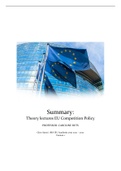Summary
Summary EU Competition Policy Theory Lectures ('21 - '22)
- Course
- Institution
Comprehensive summary of the lectures for the course EU Competition Policy of the European Union. Suitable for students International Business. Given by Caroline Buts at the Vrije Universiteit Brussel in the academic year . Allowed me to pass during the first session.
[Show more]



